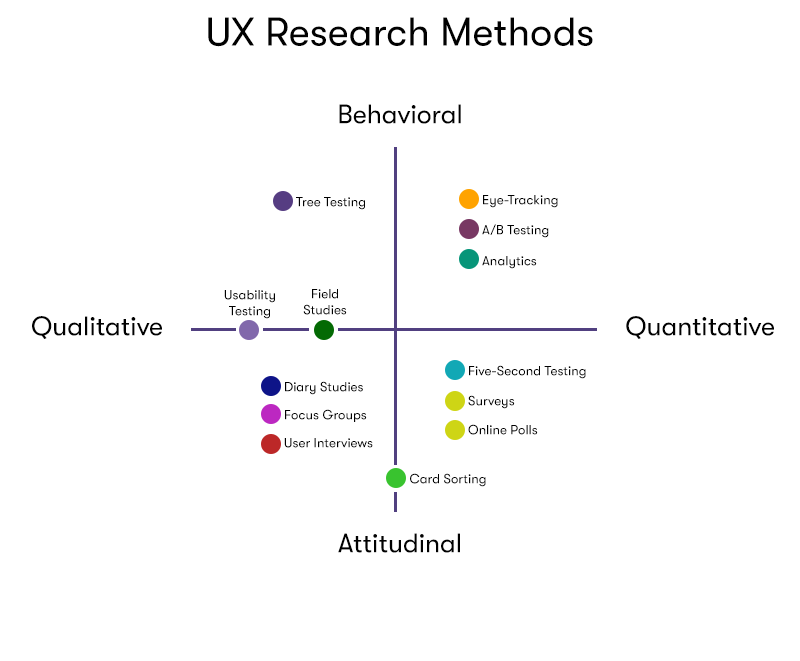What is UX Research?
What exactly is UX (User Experience) research? It's the meticulous process of understanding users' behaviours, needs, and desires. It's the cornerstone of creating products and services that function well and delight users. We'll delve into its purpose, methods, and best practices throughout this journey. UX research isn't just about data; it's about empathising with users, ensuring accessibility, and advocating for their needs. So, whether you're a seasoned UX professional or just dipping your toes, join us as we uncover the intricacies of UX research, a key to crafting exceptional user experiences.
What is UX Research?

User Experience research is a crucial component of the UX design process that focuses on understanding users' behaviours, needs, and preferences to inform the design and development of products, services, or systems. It is a systematic and methodical approach to gaining insights into how users interact with a product or service and how to improve their overall experience. Here are some key aspects of UX research:
User-Centred Approach
UX research places users at the centre of the design process. It aims to ensure that the final product aligns with user expectations and provides a positive experience.
Data Collection
Researchers use various methods to collect user data, such as interviews, surveys, observations, usability testing, and analytics. These methods help in gathering both qualitative and quantitative information.
Understanding User Needs
UX researchers seek to understand users' goals, motivations, pain points, and preferences. This information helps designers make informed decisions about features, functionality, and design elements.
Usability Testing
Usability testing involves having users interact with a prototype or the actual product while researchers observe and gather feedback. This helps identify usability issues and areas for improvement.
Persona Development
UX researchers often create user personas, which are fictional representations of typical users. These personas help designers empathise with and design for specific user segments.
Information Architecture
Researchers analyse how users navigate and search for information within a product. This informs the organisation of content and layout for better user comprehension.
Iterative Process
UX research is an ongoing and iterative process. Researchers continuously gather feedback and insights throughout the design and development lifecycle to make improvements.
Accessibility and Inclusivity
UX research also considers the needs of users with disabilities to ensure that products and services are accessible to a diverse audience.
Competitor Analysis
Researchers may analyse competitor products and user experiences to identify strengths and weaknesses, helping design teams make informed decisions.
Data-Driven Design
The insights gathered from UX research guide design decisions and help prioritise features or changes based on user feedback and data.
Collaboration
UX researchers work closely with designers, developers, product managers, and other stakeholders to ensure that user insights are integrated into the design and development process.
Overall, UX research is instrumental in creating products and services that meet user expectations, enhance usability, and ultimately lead to higher user satisfaction and business success. It helps bridge the gap between what a design team thinks is best and what users actually need and want.
What Are the Benefits of UX Research?

UX research offers numerous benefits to both businesses and users, making it an essential component of the design and development process. Here are some of the key benefits of UX research:
Improved User Satisfaction
Understanding user needs, preferences, and pain points helps UX research design products and services that align with user expectations, leading to higher user satisfaction.
Enhanced Usability
Through usability testing and user feedback, UX research identifies usability issues and areas for improvement, resulting in products that are easier to use and navigate.
Reduced Development Costs
Identifying and addressing design flaws early in the development process is more cost-effective than making significant changes after launching a product. UX research helps mitigate costly design errors.
Higher User Engagement
Products that are designed with user input and usability in mind tend to attract and retain more users. Engaged users are more likely to become loyal customers.
Increased Conversion Rates
UX research can uncover barriers to conversion, whether in e-commerce, sign-up processes, or other user actions. Optimising the user experience can lead to higher conversion rates and increased revenue.
Effective Decision-Making
Data-driven insights from UX research inform design decisions, helping teams prioritise features and improvements based on user needs and behaviours.
Enhanced Brand Reputation
Providing a positive user experience fosters trust and loyalty. Users are more likely to recommend products or services that are easy to use and meet their needs, enhancing a company's reputation.
Competitive Advantage
Companies that invest in UX research and design often have a competitive edge. They can differentiate themselves by offering superior user experiences compared to competitors.
Reduced Support and Maintenance Costs
Improved usability and fewer user issues mean lower customer support and maintenance costs.
Accessibility and Inclusivity
By considering the needs of users with disabilities, UX research promotes inclusivity and can help businesses reach a broader audience.
Alignment with Business Goals
UX research can help ensure that product development aligns with business objectives. It identifies opportunities to drive growth, customer retention, and profitability.
Iterative Improvement
UX research is an ongoing process, allowing teams to continually refine and enhance products based on user feedback and changing market conditions.
Risk Mitigation
By identifying potential issues early in the design process, UX research reduces the risk of launching a product that doesn't meet user needs or expectations.
Data for Innovation
UX research can uncover insights and opportunities for innovation, helping companies stay ahead of market trends and evolving user behaviours.
User-Centred Culture
Fostering a user-centred culture within an organisation can lead to better decision-making across various departments, from design and development to marketing and customer support.
In summary, UX research is a strategic investment that leads to improved products, higher user satisfaction, and ultimately, business success. It helps organisations create user-centred solutions that meet the needs of their target audience while achieving their own goals.
What is the Goal of UX Research?

The primary goal of UX research is to gain a deep understanding of users and their interactions with a product, service, or system. This understanding is used to inform and improve the design and development process to create user experiences that are effective, efficient, satisfying, and user-centred. Here are the specific objectives and goals of UX research:
Understand User Needs
UX research aims to uncover the specific needs, goals, and pain points of users. By understanding what users are trying to achieve and their challenges, designers can effectively create solutions that meet those needs.
Gather User Insights
Researchers seek to collect valuable insights and data about user behaviour, preferences, and expectations. This data informs design decisions and helps prioritise features and improvements.
Identify Usability Issues
One of the key goals is to identify any usability issues or obstacles that users encounter when interacting with a product. Usability testing and user feedback are essential for pinpointing these issues.
Optimise User Flow
UX research helps in understanding how users navigate through a product or service. This insight can improve information architecture, navigation, and user flows, making it easier for users to achieve their goals.
Enhance User Satisfaction
The ultimate goal is to create a positive user experience that leaves users satisfied and eager to use the product again. Research helps in identifying the factors that contribute to user satisfaction.
Minimise Cognitive Load
UX research seeks to reduce the mental effort required by users to use a product effectively. Simplifying interfaces and improving clarity are common ways to achieve this goal.
Increase Efficiency
Research helps in identifying opportunities to make tasks and interactions more efficient for users. This can lead to time savings and increased productivity.
Ensure Accessibility
Another important goal is to ensure the product is accessible to users with disabilities. UX research can uncover accessibility barriers and guide design decisions to make the product more inclusive.
Drive Business Objectives
UX research should align with the broader goals of the business. This might include increasing conversions, retaining customers, or boosting revenue. Research findings should support these objectives.
Iterative Improvement
UX research is an iterative process. Its goal is not only to inform the initial design but also to continually refine and improve the user experience based on ongoing feedback and data.
Validate Design Assumptions
Designers often have assumptions about user behaviour and preferences. UX research helps validate these assumptions with accurate user data, ensuring design decisions are grounded in evidence.
Competitive Advantage
By understanding how users interact with competing products or services, UX research can uncover opportunities to differentiate a product and gain a competitive edge.
In summary, UX research aims to create products and services that meet user needs, provide a positive experience, and align with business objectives. It systematically gathers and analyses data about users, their behaviours, and their preferences, leading to informed design decisions and iterative improvements.
What Methods Are Used During UX Research?

UX research employs various methods to gather data and insights about users and their interactions with products or services. The choice of research methods depends on the research goals, the stage of the design process, and the available resources. Here are some standard UX research methods:
|
User Interviews |
Conducting one-on-one interviews with users to understand their needs, motivations, and pain points. This method allows researchers to delve deep into individual experiences. |
|
Surveys and Questionnaires |
Collecting quantitative data from a larger sample of users to gather insights on a broader scale. Surveys are useful for assessing user preferences and demographics. |
| Usability Testing | Observing users as they interact with a prototype or the actual product to identify usability issues, navigation problems, and areas for improvement. |
|
Contextual Inquiry/Observation |
Researchers observe users in their natural environment as they use a product or perform tasks related to the product. This method provides insights into real-world usage. |
|
Card Sorting |
Users categorise and organise information or content to help researchers understand how they expect to find and access information within a product. |
|
Heatmaps and Click Tracking |
Using analytics tools to track user interactions, such as where users click, move their mouse, or spend the most time on a webpage. This helps identify user behaviour patterns. |
|
A/B Testing |
Comparing two or more variations of a design or feature to determine which performs better in user engagement, conversion rates, or other key metrics. |
|
Eye-Tracking Studies |
Employing specialised technology to track where users look on a screen or webpage. This method helps assess visual attention and user interface effectiveness. |
|
Prototype Testing |
Evaluating low-fidelity or high-fidelity prototypes to gather user feedback on design concepts and interactions before investing in full development. |
|
Diary Studies |
Users maintain diaries or journals of their experiences and interactions with a product over time, providing longitudinal insights into their evolving needs and behaviours. |
|
Customer Journey Mapping |
Visualising and analysing the user's journey through a product or service to understand touchpoints, emotions, and pain points at various stages. |
|
Competitor Analysis |
Analysing competing products or services to identify strengths, weaknesses, and opportunities for differentiation. |
|
Customer Support and Feedback Analysis |
Reviewing customer support tickets, feedback forms, and reviews to identify common issues and user concerns. |
|
Accessibility Testing |
Evaluating the product's accessibility for users with disabilities through expert reviews, user testing with individuals with disabilities, and compliance with accessibility standards. |
|
Focus Groups |
Facilitating group discussions with users to explore their opinions, preferences, and perceptions about a product or concept. |
|
Cognitive Walkthroughs |
Evaluating the product from the user's perspective to identify potential usability issues based on cognitive load and task completion. |
|
Field Studies |
Conducting research in the user's real-world environment to better understand their behaviours and needs. |
UX researchers often use a combination of these methods to gather comprehensive insights into user behaviour, preferences, and needs throughout the design and development process. The choice of methods should align with the research objectives and the specific questions researchers seek to answer.
What Are the Roles and Responsibilities of a UX Researcher?

A UX researcher plays a crucial role in designing and developing products, services, or systems by ensuring that the user's perspective is central to the process. The specific roles and responsibilities of a UX researcher may vary depending on the organisation, the project, and the team's structure, but generally, they encompass the following:
User Research Planning:
- Define research objectives and questions in collaboration with the design and product teams.
- Determine the appropriate research methods and techniques to address research goals.
- Develop research plans and timelines.
Data Collection:
- Conduct user interviews, surveys, usability tests, and other research activities to gather user insights.
- Recruit and schedule participants for research studies.
- Ensure that research sessions are well-organised and executed effectively.
Data Analysis:
- Analyse qualitative and quantitative data to derive meaningful insights.
- Identify patterns, trends, and key findings from research data.
- Translate data into actionable recommendations for the design and development teams.
Persona Development:
- Create user personas based on research findings to represent various user segments.
- Share personas with the team to build empathy and align design decisions with user needs.
Usability Testing:
- Plan and conduct usability testing sessions to evaluate the usability and effectiveness of designs or prototypes.
- Analyse usability test results and provide recommendations for design improvements.
Competitor Analysis:
- Research and analyse competing products or services to identify strengths, weaknesses, and opportunities.
- Share competitive insights with the team to inform design decisions.
Accessibility Evaluation:
- Assess the product's accessibility for users with disabilities and ensure compliance with accessibility standards.
User Feedback Analysis:
- Review and analyse user feedback, support tickets, and customer reviews to identify common issues and pain points.
Collaboration:
- Work closely with designers, developers, product managers, and other stakeholders to integrate user insights into the design and development process.
- Collaborate on design decisions to prioritise user-centred solutions.
Continuous Learning:
- Stay up-to-date with industry trends, best practices, and emerging research methodologies.
- Continually improve research skills and techniques.
Advocacy for Users:
- Advocate for the needs and perspectives of users throughout the design and development process.
- Ensure that user-centred design principles are upheld.
Communication:
- Effectively communicate research findings and insights to team members and stakeholders through reports, presentations, and discussions.
- Present findings in a clear and compelling manner to influence design decisions.
Ethical Considerations:
- Ensure that research is conducted ethically, respecting user privacy and informed consent.
- Uphold ethical standards in data handling and reporting.
Iterative Improvement:
- Support an iterative design process by continually gathering and incorporating user feedback and insights to refine and improve the product.
User-Centred Culture:
- Promote a user-centred culture within the organisation, emphasising the importance of user research in decision-making.
Project Management:
- Manage research projects, including budgeting, scheduling, and resource allocation.
In summary, a UX researcher bridges the gap between users and design teams. They are responsible for gathering, analysing, and communicating user insights to ensure products and services are designed with the user's best interests. Effective collaboration, research planning, data analysis, and advocacy for users are key skills and responsibilities of a UX researcher.
UX Research Best Practices

To ensure that UX research is effective and provides valuable insights, it's essential to follow best practices. Here are some UX research best practices:
Clearly Define Research Goals
Start each research project by defining clear and specific research goals and objectives. What do you want to learn, and how will it inform design decisions?
Involve Stakeholders
Collaborate closely with stakeholders, including designers, developers, product managers, and business leaders. Ensure they understand the value of UX research and incorporate its findings into their decision-making.
Select the Right Research Methods
Choose research methods that align with your research goals and the stage of the design process. Different methods are suitable for gathering various data types, so select the most appropriate ones.
Recruit Diverse Participants
When recruiting participants for research studies, aim for diversity in terms of demographics, backgrounds, and user personas. This ensures a broader perspective on user needs.
Create a Research Plan
Develop a research plan that outlines the research activities, timelines, and resources needed. Having a well-structured plan helps ensure that research stays on track.
Use Open-Ended Questions
In interviews and surveys, use open-ended questions encouraging participants to provide detailed and honest responses. Avoid leading or biased questions.
Maintain Neutrality
Be an impartial observer and avoid influencing participant responses. Maintain a neutral tone and avoid offering suggestions or opinions during research sessions.
Moderate Effectively
When conducting interviews or usability tests, be a skilled moderator. Ask follow-up questions to dig deeper into user responses and encourage participants to think aloud.
Respect Participant Privacy
Ensure that you obtain informed consent from participants and respect their privacy. Anonymise and protect sensitive data in accordance with privacy regulations.
Record and Document Findings
Record research sessions and take detailed notes. Document key findings, insights, and quotes from participants to support analysis and reporting.
Triangulate Data
Use multiple data sources and research methods to corroborate findings. Triangulating data increases the reliability of insights.
Analyse Qualitative and Quantitative Data
Combine qualitative data (e.g., interview transcripts) with quantitative data (e.g., survey responses) to understand user behaviour and preferences holistically.
Prioritise Findings
Prioritise research findings based on their impact on the user experience and alignment with business goals. Focus on addressing the most critical issues first.
Share Insights Actively
Communicate research findings regularly with the project team and stakeholders. Use clear and compelling visuals, reports, or presentations to convey insights effectively.
Iterate and Refine
Use research findings to inform design decisions and iterate on prototypes or products. Continue to gather user feedback and make improvements iteratively.
Stay Ethical
Adhere to ethical research practices, including obtaining informed consent, protecting participant privacy, and using data responsibly and securely.
Stay Updated
Stay current with industry trends, new research methods, and emerging technologies. Continually improve your skills and knowledge.
Maintain User-Centred Focus
Always keep the user's perspective at the forefront of design and development decisions. Advocate for user needs and preferences.
Seek Feedback
Encourage feedback from colleagues and team members to improve the research process and the quality of insights.
Evaluate and Validate
After implementing design changes based on research findings, conduct follow-up research to validate the effectiveness of those changes.
By following these best practices, UX researchers can conduct more effective research, provide valuable insights, and contribute to the creation of user-centred products and services.
How to Build a Career in UX Research?

Building a career in UX research is a rewarding journey involving education, practical experience, and continuous learning. Here are steps to help you build a career in UX research:
Educational Foundation
Start with a strong educational foundation. Many UX researchers have degrees in psychology, human-computer interaction (HCI), cognitive science, or a related discipline.
Consider enrolling in formal UX research or HCI programs, workshops, or courses to gain specific knowledge and skills in user research.
Learn the Basics
Familiarise yourself with the fundamental principles of UX design and research, including usability testing, user interviews, persona development, and user-centred design processes.
Gain Practical Experience
Build a portfolio of projects that showcase your UX research skills. If you're just starting, consider volunteering for nonprofit organisations or participating in open-source projects.
Seek internships or entry-level positions in UX research, user testing, or related roles to gain hands-on experience.
Networking
Attend UX conferences, workshops, and meetups to connect with professionals in the field. Networking can lead to job opportunities and mentorship.
Join online UX communities, forums, and LinkedIn groups to stay connected with the UX research community and learn from others.
Develop Technical Skills
Familiarise yourself with UX research tools and software, such as usability testing platforms, survey tools, data analysis software, and prototyping tools.
Learn basic coding and data analysis skills, which can be valuable for analysing research data and collaborating with development teams.
Create a Portfolio
Document your research projects in a portfolio, including methodologies, findings, and recommendations. Highlight your problem-solving skills and the impact of your research on product design.
Include case studies that showcase your ability to conduct research and make data-driven recommendations.
Specialise and Deepen Expertise
Consider specialising in a particular aspect of UX research, such as accessibility testing, mobile app usability, or e-commerce user experience.
Continuously deepen your expertise through reading books, research papers, and articles in the field.
Stay Updated
UX research is an evolving field. Stay informed about the latest trends, research methodologies, and technologies by attending conferences, webinars and reading industry publications.
Certifications
Consider pursuing relevant certifications, such as the BCS Foundation in User Experience.
Build Soft Skills
Develop soft skills like communication, empathy, collaboration, and critical thinking. These skills are essential for working effectively with cross-functional teams and stakeholders.
Apply for UX Research Positions
Start applying for entry-level UX research positions, such as UX Research Assistant or Junior UX Researcher, to begin your professional career.
Seek Mentorship
Find experienced UX researchers or mentors who can provide guidance, feedback, and career advice. Mentorship can accelerate your learning and career progression.
Contribute to the Community
Share your knowledge and experiences by writing articles, giving presentations, or contributing to UX blogs and forums. It can help you establish yourself as a thought leader in the field.
Advance Your Career
As you gain experience, aim for more senior roles such as UX Researcher, Senior UX Researcher, or UX Research Manager. You may also explore roles in UX strategy or leadership.
Continuous Learning
UX research is a dynamic field, so commit to lifelong learning. Stay curious, adapt to new tools and methodologies, and be open to exploring emerging areas of UX research.
Remember that building a career in UX research takes time and dedication. Be patient, persevere through challenges, and refine your skills to become a proficient and sought-after UX researcher.
Where Can You Learn More About UX?
Our BCS Foundation Certificate in User Experience training course is perfect for anyone who wants to increase their knowledge of User Experience. The BCS User Experience course will teach you the UX methodology, best practices, techniques, and a strategy for creating a successful user experience. The course will cover the following topics:
- Guiding Principles.
- User Research.
- Illustrating The Context of Use.
- Measuring Usability.
- Information Architecture.
- Interaction Design.
- Visual Design.
- User Interface Prototyping.
- Usability Evaluation.
Click the button below to find out more.

Final Notes on UX Research
UX research, a critical aspect of user-centred design, involves understanding user needs, preferences, and behaviours to create better products and services. This practice employs various methods such as interviews, surveys, usability testing, and more.
The key goals are to enhance user satisfaction, improve usability, and align design with business objectives.
UX researchers should possess planning, data collection, analysis, and effective communication skills. Following best practices, building a portfolio, networking, and continuous learning are essential for a successful UX research career. A commitment to user-centricity ultimately drives success in this dynamic and rewarding field.



